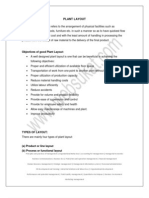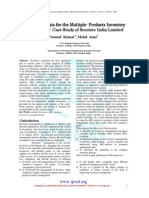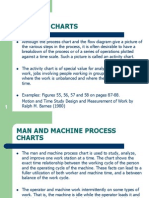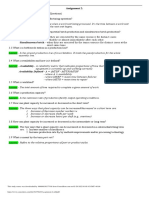75%(4)75% found this document useful (4 votes)
1K viewsSolution of Assignment 1
1) The document contains solutions to 4 assignments related to operations management.
2) The first assignment uses Little's law to show that a government department's claim of completing projects in under 6 months on average is incorrect based on current inventory levels.
3) The second assignment calculates the capacity, bottleneck, and resource utilization of a multi-machine production process and determines if capacity would increase with a shorter assembly time.
4) The third assignment uses queuing theory to determine the optimal crew size for servicing vending machines that break down according to a Poisson process.
5) The fourth assignment involves drawing a critical path diagram and calculating early/late start and finish times for a project with multiple dependent
Uploaded by
Anonymous 8O9X3QtR4Copyright
© © All Rights Reserved
Available Formats
Download as PDF, TXT or read online on Scribd
75%(4)75% found this document useful (4 votes)
1K viewsSolution of Assignment 1
1) The document contains solutions to 4 assignments related to operations management.
2) The first assignment uses Little's law to show that a government department's claim of completing projects in under 6 months on average is incorrect based on current inventory levels.
3) The second assignment calculates the capacity, bottleneck, and resource utilization of a multi-machine production process and determines if capacity would increase with a shorter assembly time.
4) The third assignment uses queuing theory to determine the optimal crew size for servicing vending machines that break down according to a Poisson process.
5) The fourth assignment involves drawing a critical path diagram and calculating early/late start and finish times for a project with multiple dependent
Uploaded by
Anonymous 8O9X3QtR4Copyright
© © All Rights Reserved
Available Formats
Download as PDF, TXT or read online on Scribd
You are on page 1/ 3
MSM 206: Operations Management
Suggested Solution of Assignment 1
1. A government department, on average, completes 300 projects per year. According to a
report, the number of projects currently on the departments plate is 588. The department
head claims that average time to complete a project is under six months. Do you have any
reason to disagree?
Solution:
Flow rate =300 projects per year;
Inventory =588 projects.
According to Littles law, Flow time =Inventory / Flow rate =588 / 300 =1.96 year.
We cannot agree with the claim of the department head.
2. Product P is made in-house by assembling two parts (parts 1 and 2): Part 1 is first processed
on machine A for 15 minutes per unit and then processed on Machine B for 10 minutes per
unit. Part 2 is processed on machine C for 20 minutes per unit. An assembler then assembles
the two parts, with the assembly operation taking 15 minutes. The process flow diagram is
given below.
(a) What is the capacity of the process? Where is the bottleneck?
(b) Assuming that the process is running at maximum capacity, calculate the utilization of
each resource.
(c) Suppose the assembler has come up with an innovation that can reduce assembly time
from 15 to 10 minutes. As a result of this innovation, will the process capacity
increase, decrease or remain unchanged? J ustify your answer.
Solution:
(a) Capacity of machine A =4 units per hour;
Capacity of machine B =6 units per hour;
Capacity of machine C =3 units per hour;
Capacity of assembly operation =4 units per hour.
The bottleneck of sub line with machines A & B is machine A and the resulting capacity
is 4 units per hour.
Because capacity of machine C is less than that of sub line with machines A & B and
capacity of assembly operation is larger than that of machine C, we know the bottleneck
of the whole process is machine C and the resulting capacity is 3 units per hour.
(b) Utilization of machine A =3/4 =75%;
Utilization of machine B =3/6 =50%;
Machining
Part 1 on A
Machining
Part 1 on B
Machining
Part 2 on C
Assembling
Parts 1 and 2
Utilization of machine C =3/3 =100%;
Utilization of assembly operation =3/4 =75%.
(c) With the innovation, capacity of assembly operation becomes 6 units per hour. Because
the assembly operation is not the bottleneck of the process, such innovation has no impact
on the process capacity.
3. American Vending Inc. (AVI) supplies vended food to a large university. Because students
often kick the machines out of anger and frustration, management has a constant repair
problem. The machines break down on an average of three per hour, and the breakdowns are
distributed in a Poisson manner. Downtime costs the company $25 per hour per machine, and
each maintenance worker gets $4 per hour. One worker can service machines at an average
rate of five per hour, distributed exponentially; two works working together can service seven
per hour, distributed exponentially; and a team of three workers can do eight per hour,
distributed exponentially. What is the optimal maintenance crew size for servicing the
machines? (Hint: Use the excel file Note04B_Qmmc.xls, sheet MMc)
Solution: (See Textbook Page 260 Solved Problem 2)
One worker: the average number of machines in the system is 1.5 machines, and the
corresponding cost is 1.5 x $25 +1 x $4 =$41.50.
Two workers: the average number of machines in the system is 0.75 machines, and the
corresponding cost is 0.75 x $25 +2 x $4 =$26.75.
Three workers: the average number of machines in the system is 0.6 machines, and the
corresponding cost is 0.6 x $25 +3 x $4 =$27.00.
Hence, the optimal maintenance crew size is two workers.
4. A project has been defined to contain the following list of activities, along with their required
times for completion:
Task Time Required (weeks) Immediate Predecessors
A 3 -
B 4 A
C 2 A
D 6 B, C
E 5 C
F 3 C
G 7 E
H 5 E, F
I 8 D, G, H
(a) Draw the critical path diagram.
(b) Show the early start, early finish, late start, and late finish times.
(c) Show the critical path.
Solution:
You might also like
- Download Full Quantitative Methods for Business 13th Edition by David R. Anderson (eBook PDF) PDF All Chapters100% (2)Download Full Quantitative Methods for Business 13th Edition by David R. Anderson (eBook PDF) PDF All Chapters41 pages
- Ba4204 Operations Management All Units 13 Marks Questions and Answers67% (3)Ba4204 Operations Management All Units 13 Marks Questions and Answers25 pages
- Session 3 Framework of Production Management100% (1)Session 3 Framework of Production Management7 pages
- One of The Micro-Operations Is Maintenance of The Whole Site. Maintransformed Resources AreNo ratings yetOne of The Micro-Operations Is Maintenance of The Whole Site. Maintransformed Resources Are2 pages
- Vietnam Some Points On Market Entry DecisionsNo ratings yetVietnam Some Points On Market Entry Decisions4 pages
- Analyse Whether OYO Has A Sustainable Competitive Advantage Using100% (1)Analyse Whether OYO Has A Sustainable Competitive Advantage Using4 pages
- DMAIC Process Used For Academic Case Analysis: Article SubmissionNo ratings yetDMAIC Process Used For Academic Case Analysis: Article Submission14 pages
- Question Set Manufacturing System Analysis & Management100% (1)Question Set Manufacturing System Analysis & Management10 pages
- Definition: Plant Layout Refers To The Arrangement of Physical Facilities Such AsNo ratings yetDefinition: Plant Layout Refers To The Arrangement of Physical Facilities Such As5 pages
- Assignment-Industrial Engineering and ManagementNo ratings yetAssignment-Industrial Engineering and Management7 pages
- HR - Om11 - ch03 PPT Manajemen Operasi Sesi 5No ratings yetHR - Om11 - ch03 PPT Manajemen Operasi Sesi 558 pages
- Corr UBS Mumbai MBA7061 Operations Management Draft Assessment Approval Proforma Cardiff Aug Cohort 2015 16No ratings yetCorr UBS Mumbai MBA7061 Operations Management Draft Assessment Approval Proforma Cardiff Aug Cohort 2015 1613 pages
- A Study of Lean Methodology by 5S Application With Reference To TCS Chennai - V2 PDFNo ratings yetA Study of Lean Methodology by 5S Application With Reference To TCS Chennai - V2 PDF58 pages
- Mcdonald'S, A Guide To The Benefits of Jit: Just-In-Time (Jit)No ratings yetMcdonald'S, A Guide To The Benefits of Jit: Just-In-Time (Jit)7 pages
- Why Operations Management Is Important For A Company PDFNo ratings yetWhy Operations Management Is Important For A Company PDF4 pages
- 028,029,034,057,066 - A Day in Life of Frederic Gode100% (1)028,029,034,057,066 - A Day in Life of Frederic Gode12 pages
- Assignment - MBA-302 Operations ManagementNo ratings yetAssignment - MBA-302 Operations Management3 pages
- Project Plan: Critical Path Method: STEP 1: Identify The Logic Network100% (1)Project Plan: Critical Path Method: STEP 1: Identify The Logic Network5 pages
- Time Management Practices in Large Construction ProjectsNo ratings yetTime Management Practices in Large Construction Projects5 pages
- Microsoft PROJECT 2007: A Quick Reference Guide For MSP2007 By: Mani SrikanthNo ratings yetMicrosoft PROJECT 2007: A Quick Reference Guide For MSP2007 By: Mani Srikanth11 pages
- Impact of Efective Construction PlanningNo ratings yetImpact of Efective Construction Planning12 pages
- Critical Path Method (CPM) in Project ManagementNo ratings yetCritical Path Method (CPM) in Project Management8 pages
- Resource Optimization of Construction PRNo ratings yetResource Optimization of Construction PR8 pages
- Activity Relationship Types Activity Relationship Types: X Y X YNo ratings yetActivity Relationship Types Activity Relationship Types: X Y X Y5 pages
- Network Analysis For Planning and Control of Maintenance WorkNo ratings yetNetwork Analysis For Planning and Control of Maintenance Work30 pages
- Object-Oriented Software Engineering: Practical Software Development Using UML and JavaNo ratings yetObject-Oriented Software Engineering: Practical Software Development Using UML and Java65 pages
- Unit 6 Resourses and Support InstitutionsNo ratings yetUnit 6 Resourses and Support Institutions18 pages

























































































